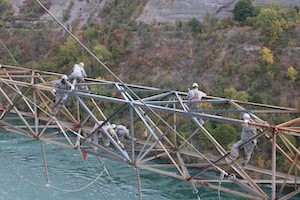BuildForce Canada outlook projects shortfall of 52,000 workers in Ontario by 2034
BuildForce Canada’s latest outlook for Ontario’s construction sector projects that the province could be short as many as 52,000 workers by 2034, unless the industry is able to find new sources of workers.
 The organization released its 2025–2034 Construction and Maintenance Looking Forward report for Ontario earlier this week. The forecast calls for overall construction growth by 2034, but with growth principally driven by activity in the residential sector.
The organization released its 2025–2034 Construction and Maintenance Looking Forward report for Ontario earlier this week. The forecast calls for overall construction growth by 2034, but with growth principally driven by activity in the residential sector.
Construction activity in the province’s residential sector has been held back in recent years by elevated interest rates and affordability concerns. BuildForce projects that lull will continue through this year, before changing course, and rising steadily to the end of the decade.
It expects that pent-up demand and elevated levels of migration to the province will spark increasing levels of new housing construction into the early 2030s. This, in turn, will be supplemented by growth in demand for residential renovations.
On the other hand, work in the non-residential sector continues to trend upward on the strength of a large volume and wide range of major projects across all regions and throughout the engineering construction sector and in the construction of ICI buildings.
These include major transit, utilities, nuclear, mining, and roads, highways and bridges projects on the engineering construction side, and healthcare, education, and government projects on the ICI construction side.
Activity on these projects is projected to rise to a peak in 2027 before investment levels slow into 2030 and then remain stable, but at an elevated level, to the end of the decade.
BuildForce anticipates these trends will combine to increase construction employment in the residential sector by 13% by 2034, and by 10% in the non-residential sector. It adds that its report does not take into account the potential impacts of tariffs on Canada’s trading relationship with the United States, or its other major economic partners.
As it grows, the industry will have to contend with large numbers of retirements. The report projects that by 2034, as many as 90,300 workers will exit the industry due to retirement. When combined with the additional 63,800 workers required to keep pace with increasing demand over the forecast period, the industry could face hiring requirements of 154,100 workers by 2034. A large portion of this figure is expected to be offset by the addition of 102,200 new entrant workers under the age of 30 from within the province over the forecast period.
“Growth in construction activity in Ontario through to the end of the 2020s are expected to tighten labour market conditions for many trades and occupations across both the residential and non-residential sectors in most regions of the province,” says Bill Ferreira, Executive Director of BuildForce Canada. “The province is seeing, and will continue to see, intense levels of demand for both residential and non-residential construction until at least the early 2030s. What’s more, it is unlikely workers will have significant incentives to move among regional markets, given the high levels of demand we are forecasting across the province.”
Across the regions
Construction activity in Central Ontario is expected to increase across the forecast period. Although activity in the region’s residential sector has moderated since it peaked in the early 2020s, it is poised to grow again in 2026 and to the end of the decade. Growth is anticipated in demand for new housing as well as residential renovations. Activity in the region’s non-residential sector is more cyclical. Growth is projected into 2027 with ongoing work on several healthcare and industrial projects. Meanwhile, activity in engineering construction is driven primarily by proposed major light rail projects in Hamilton and Kitchener-Waterloo-Cambridge. By 2034, employment is expected to rise in both the residential (14%) and non-residential (15%) sectors.
In Eastern Ontario, elevated interest rates and affordability concerns have slowed residential sector growth in recent years. The outlook calls for growth in the residential sector in 2025 and beyond, with renewed demand for new housing, and for single-detached units in particular. Growth in residential renovations is more gradual. The region’s non-residential construction sector, meanwhile, continues to function at an historically high level. Construction is ongoing on a long list of major projects across both the engineering construction sector and in the construction of industrial, commercial, and institutional buildings. Levels are projected to peak in 2027, after which they remain sustained at an elevated level to the end of the forecast period. Construction employment in the region is expected to grow across the forecast period, with greater gains in the residential sector (19%) than in the non-residential sector (7%).
The Greater Toronto Area saw another contraction in residential construction activity in 2024. Activity in the sector is expected to return to growth in 2026, with investment in both new housing and residential renovations expected to rise across the forecast period. Non-residential construction activity, meanwhile, continues to be driven by a large volume of major projects that are underway in both the engineering construction sector (in the form of public transit systems, utilities projects, and work on roads, highways, and bridges projects) and in the construction of ICI buildings (on healthcare and education sector projects). Investment levels are projected to rise into 2027 before slowing as work concludes on the region’s major transit projects. Across the forecast period, construction employment in the GTA is projected to rise in both the residential (14%) and non-residential (10%) sectors.
Activity in Northern Ontario’s non-residential construction sector slowed in 2024 as several major engineering construction projects concluded. This was offset somewhat by elevated levels of activity in the construction of ICI buildings. Investment levels are expected to fluctuate across the outlook period, but remain relatively elevated given work on major projects, including correctional facilities, a major hospital, and several mining and utilities projects. The outlook for the region’s residential sector calls for new-housing investment to return to growth in 2025 and to carry through to 2026 before stabilizing at an elevated level to 2030 as interest rate pressures ease. These trends combine to contract overall employment in the region, as a gain of just over 4% in non-residential construction employment is not sufficient to offset a contraction of 10% in residential employment.
Southwestern Ontario saw growth in both the residential and non-residential construction sectors in 2024. The outlook calls for the residential sector to continue to grow to the end of the forecast period, with activity driven primarily by the increased construction of single-detached homes. Investment levels in the region’s non-residential construction sector are projected to fluctuate across the forecast period with the ebb and flow of major projects. They moderate slightly with the conclusion of work on the Gordie Howe International Bridge and NextStar Energy electric battery facility, then are held steady by ongoing nuclear refurbishment work at Bruce Power, and rise thereafter with the start of work at the St Clair Hydrogen power plant and the Windsor Acute Care Hospital. Employment rises in both the residential (11%) and non-residential (4%) sectors across the outlook scenario.








